Presentation by Pamela Z

As part of our Sonification and Sound Design course (MCT4046), we were fortunate enough to host scholars and artists which are well established within the sonification and sound design field. Pamela Z is a composer, performer and a media artist who is known for her work of voice with electronic processing. Pamela arrived in Norway for several workshops and performances, and we were lucky enough to have her for a short presentation on April 4th. After a brief introduction by Tone Åse who has been a long-time fan of Pamela’s work, Pamela started the session with a 10 minutes performance of a live improvised mashup of several existing pieces she often performs. While performing, Pamela is being circled by several self-made sensory devices that are connected to her laptop. On her hands, she wears sensors that send signals to her hardware setup. She sings and makes sounds with her voice, hands, and body and manipulates all that with hand gestures. In the video below Pamela Z is using more or less the same setup she presented during her talk in Oslo.
Pamela started describing the basics she’s been using on any given performance. She sings and records her voice in real-time. Both the recorded voice samples and the live singing can be processed and manipulated by her during the live performance. Most of the processing is based on digital delay. She captures and samples her voice, creates layers and processes the sampled and real-time audio. Pamela processes her voice through Max/MSP and can layer, loop and alter her live vocal sound. Some of her most used plug-ins are Shuffling and Freeze by GRM tools. In her earlier years, she has used hardware racks full of digital delay units, multi-effects processors and samplers. Her first delay pedal was recommended to her after a concert where Jaco Pastorius was performing with effects. Pamela described her first experience realizing the artistic potential of layering and how she immediately was immersed in the experience of building textures and rhythms from her voice. It was a moment when all her artistic output was changed “I found my voice as an artist when I started playing with processing” she added. Earlier work by Pamela Z can be seen in the video below.
She developed her skill using effects, mostly delay, and began to learn more about out-of-phase delays which allow for more textures and timbres. In the early 1990s, she introduced a gesture control in her work with the "Body Synth", a wearable MIDI controller that allowed her to control sound through gestures. It includes a belt with sensor sensitivity adjustment knobs. The suite and the CPU unit translates muscular effort into numbers. The numbers are being mapped to different musical parameters and triggers depending on the musical piece. Check out Pamela's performance at TEDxStanford from 2012.
